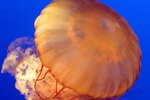
Anglerfish are saltwater dwellers with bony body structures. More than 200 anglerfish species exist, primarily around continental shelves and in the depths of the world's oceans. Named for the fleshy, hanging, lighted lures that grow from the females' heads, these fish are carnivorous hunters.
Fishing for Food
The anglerfish diet is carnivorous, and these vicious-looking fish are not picky eaters. From crustaceans to eels to large fish, the species consume almost any creature they can lure with the fleshy, ball-like organ that dangles near their mouths, called photophores. These light-emitting organs are located at the end of the head appendage, actually extension of these species' dorsal spines. However, only female angerfish have these unique body structures; the males of these species depend on the females for sustenance.
Male Anglerfish Nourishment
The diet of the male anglerfish is basically whatever the female catches with her lure, because these species have a unique trait that makes the males parasitic. When the male anglerfish reaches adulthood, his digestive system no longer functions. When this happens, each male anglerfish finds a female to attach to by biting into her flesh and fusing to her body. From this point on, the male and female angler fish share the same bloodstream, and the male gets nourishment from her diet through the shared bloodstream.
Crustaceans, Snails and Small Fish
It's common for anglerfish to attract small creatures to their lures and into their large jaws. Shrimps, tiny fish species, baby fish, copepods and sea snails often become dinner for these carnivorous ocean dwellers as they wait motionlessly while their photophores do their hunting for them. Small sea animals are more common in the dark, isolated depths of oceans than larger fish, and make up a large part of the angler fish diet.
Large Prey
Though anglerfish range in size from several inches to several feet in length, there sizes do not inhibit their diets. Because the species have large jaws that snap tightly shut, and flexible bodies and active digestive systems, these fish can eat prey up to twice their sizes. Eels, haddock, squids, octopuses, cod and even sea turtles fall for the lure on the heads of female anglerfish and end up becoming dinner as the angry-looking fish shut their large jaws around their prey.
References
Photo Credits
-
Tom Brakefield/Stockbyte/Getty Images
Writer Bio
Jennifer Lynn has been writing as a correspondent and reporter since 1991. She has written for numerous newspapers and currently writes as a correspondent for Gannett. Lynn has a Bachelor of Arts with a focus on English from Ohio University, where she also studied journalism at the E.W. Scripps School of Journalism.




